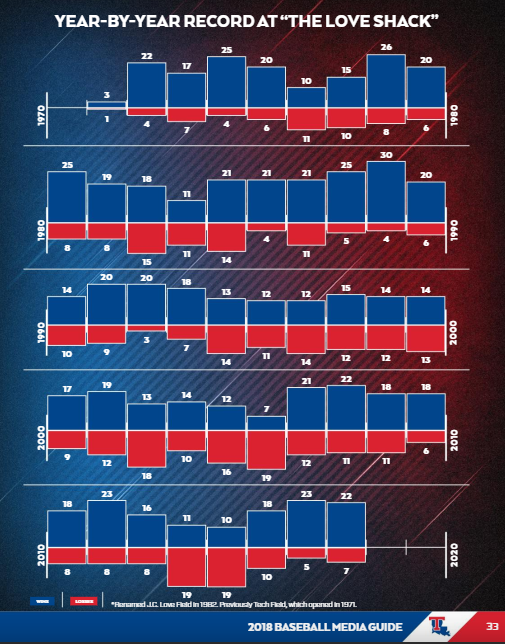On April 8th, Hunter Wells accomplished something that doesn’t happen often in baseball: he hit for the cycle. That means Wells hit a single, a double, a triple, and a home run in a single game. Sounds simple enough, right?
Well, in the majors, cycles have only happened 319 times. That’s dating back to the first recorded cycle in 1876. 319 times in 142 years is just over two a year. And there are a lot of baseball games played in a year.
When Wells homered in the top of the seventh on April 8th, Dave Nitz speculated whether or not this was the first time in Tech’s history a player had hit for the cycle. When Mason Robinson hit for the cycle ten days later against ULL, the same question arose: has a Bulldog done this before?
Wells was it? Or did a former Tech player Robinson Wells of that title. (Okay, I’ll stop.)
Has a Tech Player Hit For the Cycle Before
Before we get too far, I want to address the two things that make this a difficult question to answer:
A “cycle” is not really a stat in baseball in the same way a “Home Run” or “Double” is. Instead, it is a collection of stats. So, for example, while the NCAA keeps a record of every player who hit a triple this year, they don’t keep a record of cycles.
And second, Tech baseball has been playing for a long time, much of which is not well documented. So finding the stats we need may not always be possible.
When you add those together, you get a pretty big problem. So instead of going through every Tech game ever played searching for a cycle, let’s first see how likely it is that a Tech player has hit for the cycle before.
Probabilities and Stuff
Fangraphs lists the odds of getting a cycle for any particular player in any particular game at 0.0044%. That’s gives us a 0.0396% chance per game for any player (0.0044% * 9). So we should expect a cycle every 2,525 games. But how many games has Tech played?
Finding out when exactly Tech baseball “started” is surprisingly difficult. Like any good millennial, the first thing I did was go to Wikipedia. This infallible source lists Tech baseball’s founding date as 1894 (the same as the University’s), but lists the first coach for the Bulldogs as Henry Gwinner in 1902. (Interestingly, Gwinner was also the Head of the Mechanic Arts Department at the time.) So for our purposes, let’s assume Tech baseball has been around since 1902.
But now the next question: how many games did Tech play in each of those years? The only reference to a game played before 1945 I could find was the time the Bulldogs beat the New York Yankees in 1929. I checked the official media guide, where the first listed season in the guide is 1971:

Per the media guide, Tech has played 1,279 baseball games between 1971 and 2017. So although we know Tech baseball has been around since 1902, let’s first do the math going back to 1971.
The Math Part
Nobody is going to fault you if you want to skip this math part, but I barely passed took eight math classes at Tech, so I want to make that decision seem worth it.
Let’s say A is the probability of a Tech player hitting for the cycle in Game #1 and B will be the probability of this happening in Game #2. The probability equation for this is:
P (A ∪ B) = P(A) + P(B) – [P(A) * P(B)]
(∪ is just a weird symbol that means “union,” or basically the probability of both A and B happening.)
So the probability of a player to get a cycle in either of two games is:
P ((0.000396) ∪ (0.000396)) = (0.000396) + (0.000396) – [(0.000396) * (0.000396)]
= 0.000791843184 ≈ .08% chance
So what about three games? We’ll use C for Game #3.
P ([A ∪ B] ∪ C) = P (0.000791843184 ∪ 0.000396) ≈ 0.0011875 ≈ .12% chance
So to do 1,279 games, you just do this process 1,279 times by hand. Eventually, you get the overall probability of 39.77%.
Back to the Not So Math Part
Above, we found out that there is a 39.77% chance that a Tech player hit for a cycle since Tech joined Southland Conference. But what about before 1971?
Baseball-Reference.com lists Tech season records going back to 1945. Yay! More data or something! Between 1945 and 1971, Tech played 640 games of baseball. Using the calculator app on my phone, I found out that 1,279 + 640 = 1,919.
Using the confusing math stuff from before, we find the new probability is 53.26%.
Okay, So What About Before 1945?
The only list of Tech games played before 1945 is in a non-cited section on that Wikipedia entry from earlier. That list adds 168 games between 1902 and 1945. I wasn’t able to find that data anywhere else, so I’m going to just blindly trust Wikipedia here.
That brings us to a grand total of 2,087 games in Tech baseball history. Doing probability things again gives us a final answer of 56.26%. So a 56.26% chance that a Tech player hit for the cycle before this year.
But I Want Proof
For actual proof, we need to look at the box scores. Unfortunately, unlike in the majors, college baseball does not have a consistent database of box scores dating back to 1871.
LATechSports.com has box scores dating back to the distant year of 2008. After doing some fancy Googling, I found that WACSports.com has box scores dating back to when Tech joined the Western Athletic Conference in 2002.
Trying to find box scores from games before 2002 turned out to be a fruitless endeavor. But we can look at that collection of the games between 2002 and 2018. Maybe we’ll get lucky?
So I went through all 471 box scores during those 16 years and found no cycles, but a Bulldog with a familiar last name got about as close as you can get:
February 26, 2002
Wade Robinson, a shortstop for Tech, started in the leadoff position in a 14-7 loss to Mississippi State at JC Love Field. In that game Robinson had a home run, a triple, two doubles, and no singles.
So had Wade Robinson stopped at first on one of his doubles, he would have hit for the cycle. And I would have had an easy answer to the overall question of this post.
Did Anybody Else Get Close?
In addition to Wade Robinson in 2002, two other Diamond Dogs were able to get a double, triple, and home run in the same game: Devon Dageford in 2009 in Hawaii, and Brent Diaz against FIU last year.
Loosening the requirements to players who hit a triple and home run in the same game, we get a list of six players:
| Name | Year | Opponent(s) |
| Brian Rike (2) | 2006 | USM & Nevada |
| Jericho Jones | 2007 | UT-Arlington |
| Albie Goulder | 2007 | Lamar |
| Devon Dageford (2) | 2009 | NSU & NM State |
| Brent Diaz (2) | 2015/16 | Grambling & Rice |
| Taylor Love (2) | 2015/16 | UTSA & Rice |
So only a handful of Bulldogs have even gotten close to a cycle in the past 16 years.
Conclusion
We have no proof a Tech player hit for a cycle before Mason Robinson and Hunter Wells accomplished the feat last month.
And the probability that a player has done it before? It’s not much better than a coin flip.

